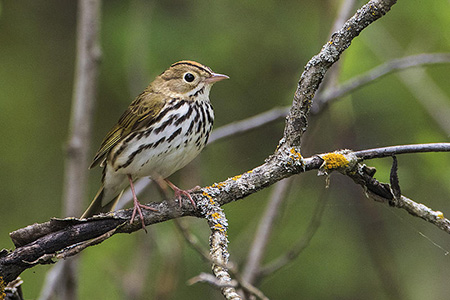This ground-dwelling, large-bodied warbler is more often heard than seen thanks to its distinctive and loud “teacher-teacher-teacher-teacher” song.
Ovenbird
(Seiurus aurocapilla)
Habitat Ecology
- The Ovenbird is most common in large, contiguous deciduous or mixed forest with the following habitat features:1,2
- Closed canopy (60–90%).1
- Lower understory cover but deep leaf litter,1 which improves cover for nests and increases invertebrate prey.3
- The Ovenbird is most strongly associated with mature and older forests, however it has been observed in stands as young as 11–14 years post-disturbance, suggesting some flexibility in its use of forested habitats.2,4
- This species shows a slight increase following spruce budworm outbreaks.5

Response to Forest Management
- Overall, Ovenbird is considered a forest-interior species that is sensitive to even low-intensity harvesting in the short term (e.g., harvest with 30–40% retention).3,6–8
- However, this species was observed using clearcut (i.e., no planned retention) harvest stands 15–33 years postharvest, suggesting rapid recovery on harvested sites as leaf litter from regenerating vegetation becomes thick—however, occupancy was consistently higher in unharvested forest.9
- In Saskatchewan, Ovenbirds responded positively to large aggregated harvests (250–400 ha and 1,200–2,700 ha) compared with postfire stands and salvage-logged burns.10
Stand-level Recommendations
- High retention levels (e.g., 70 trees/ha with ≥30 cm dbh or >30% retention) may affect this species less negatively than clearcuts in the short term by providing greater canopy closure and leaf litter,1 however at least one study suggests that 20–50% dispersed retention has a limited positive effect up to 15 years postharvest.11
- The negative effects of clearcutting may be limited to the first 15 postharvest years provided regenerating deciduous vegetation produces deep leaf litter, yet this may represent lesser-quality habitat.9
- Patches of closed-canopy, mature deciduous trees with low understory cover and deep leaf litter are recommended within harvested stands. Patch sizes, amount, and distribution should be consistent with the region’s natural range of variation (but see Landscape-level Recommendations).12,13
Landscape-level Recommendations
- Large blocks of young to mature forest (e.g., 30–100 years14), represented according to the area’s natural range of variation, will likely contribute the most important habitat for Ovenbirds to successfully breed.
- On heavily fragmented landscapes, protection of very large (>500 ha) forests with >90 ha in “core habitat” is recommended to reduce the risk of local population declines.15
- “Core habitat” is defined as habitat >100 m from an edge, because Ovenbirds have been shown to experience negative edge effects within 100–300 m of cutblock edges.16
- Riparian buffers ≥100 m are necessary to accommodate an Ovenbird territory,17 but smaller buffers may provide corridors for dispersal.18
References
- Porneluzi, P., Horn, M. A. Van & Donovan, T. M. 2011. Ovenbird (Seiurus aurocapilla), version 2.0. in The Birds of North America (Rodewald, P. G., ed.) Cornell Lab of Ornithology, Ithaca, New York, USA. Available online: https://doi.org/10.2173/bna.88
- Schieck, J. & Song, S. J. 2006. Changes in bird communities throughout succession following fire and harvest in boreal forests of western North America: literature review and meta-analyses. Canadian Journal of Forest Research 36: 1299–1318. Available online: https://doi.org/10.1139/x06-017
- Vanderwel, M. C., Malcolm, J. R. & Mills, S. C. 2007. A meta-analysis of bird responses to uniform partial harvesting across North America. Conservation Biology 21: 1230–1240.
- Hobson, K. A. & Schieck, J. 1999. Changes in bird communities in boreal mixedwood forest: Harvest and wildfire effects over 30 years. Ecological Applications 9: 849–863.
- Venier, L. A., Pearce, J. L., Fillman, D. R., McNicol, D. K. & Welsh, D. A. 2009. Effects of Spruce budworm (Choristoneura fumiferana (Clem.)) outbreaks on boreal mixed-wood bird communities. Avian Conservation and Ecology 4: 3.
- Schieck, J., Stuart-Smith, K. & Norton, M. 2000. Bird communities are affected by amount and dispersion of vegetation retained in mixedwood boreal forest harvest areas. Forest Ecology and Management 126: 239–254.
- Tittler, R., Hannon, S. J. & Norton, M. R. 2001. Residual tree retention ameliorates short-term effects of clear-cutting on some boreal songbirds. Ecological Applications 11: 1656–1666.
- Norton, M. R. & Hannon, S. J. 1997. Songbird response to partial-cut logging in the boreal mixedwood forest of Alberta. Canadian Journal of Forest Research 27: 44–53. Available online: http://www.nrcresearchpress.com/doi/abs/10.1139/x96-149
- Leston, L., Bayne, E. & Schmiegelow, F. 2018. Long-term changes in boreal forest occupancy within regenerating harvest units. Forest Ecology and Management 421: 40–53. Available online: https://doi.org/10.1016/j.foreco.2018.02.029
- Van Wilgenburg, S. L. & Hobson, K. A. 2008. Landscape-scale disturbance and boreal forest birds: Can large single-pass harvest approximate fires? Forest Ecology and Management 256: 136–146. Available online: https://doi.org/10.1016/j.foreco.2008.04.017
- Odsen, S. G. 2015. Conserving Boreal Songbirds Using Variable Retention Forest Management. Master of Science. Dept. Renewable Resources, University of Alberta, Edmonton, AB. 84 pp.
- Merrill, S. B., Cuthbert, F. J. & Oehlert, G. 1998. Residual patches and their contribution to forest-bird diversity in northern Minnesota aspen clearcuts. Conservation Biology 12: 190–199. Available online: http://www.jstor.org/stable/pdf/2387474.pdf
- Mattsson, B. J. & Niemi, G. J. 2006. Factors influencing predation on Ovenbird (Seiurus aurocapilla) nests in northern hardwoods: interactions across spatial scales. The Auk 123: 82–96. Available online: http://www.jstor.org/stable/4090630
- Bonar, R. 2018. Personal Communication.
- Burke, D. M. & Nol, E. 2000. Landscape and fragment size effects on reproductive success of forest-breeding birds in Ontario. Ecological Applications 10: 1749–1761. Available online: http://www.jstor.org/stable/2641236
- Flaspohler, D. J., Temple, S. A. & Rosenfield, R. N. 2001. Effects of forest edges on ovenbird demography in a managed forest landscape. Conservation Biology 15: 173–183. Available online: https://doi.org/10.1111/j.1523-1739.2001.99397.x
- Lambert, J. D. & Hannon, S. J. 2000. Short-term effects of timber harvest on abundance, territory characteristics, and pairing success of ovenbirds in riparian buffer strips. The Auk 117: 687–698.
- Machtans, C. S., Villard, M.-A. & Hannon, S. J. 1996. Use of riparian buffer strips as movement corridors by forest birds. Conservation Biology 10: 1366–1379.








